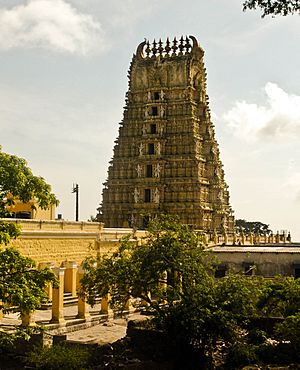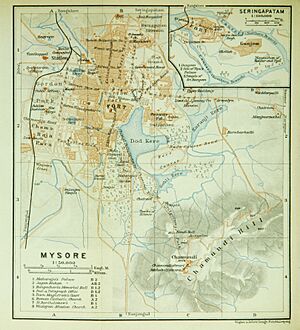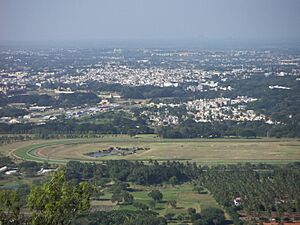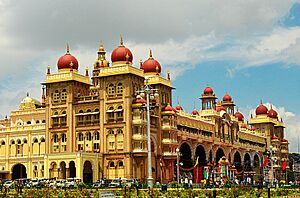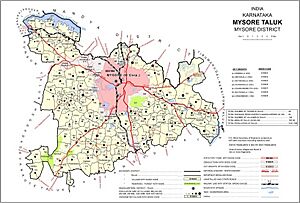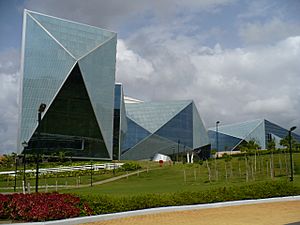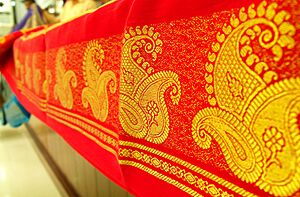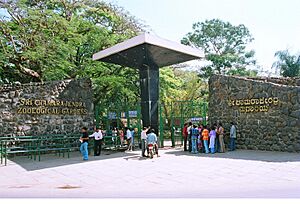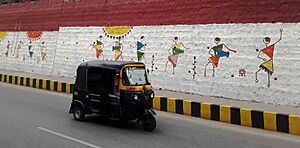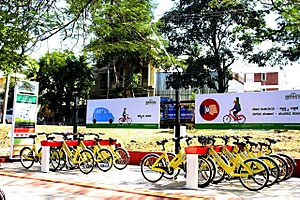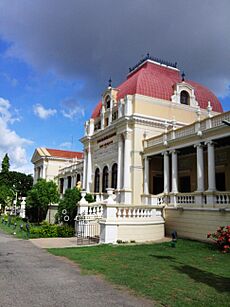Mysore facts for kids
Quick facts for kids
Mysore
|
|
|---|---|
|
Metropolitan City
|
|
| Mysuru | |
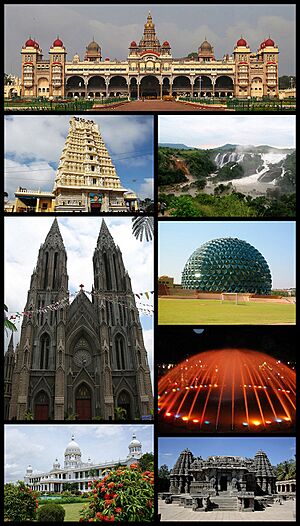
Clockwise from top: Mysore Palace, Shivanasamudra Falls, Infosys Multiplex, Brindavan Gardens at Mandya, Somanathapura, Lalitha Mahal, St. Philomena's Cathedral and Chamundeshwari Temple.
|
|
| Nicknames:
Heritage City, City of Palaces, The Cultural capital of Karnataka, Sandalwood City, City of Jasmine
|
|
| Country | India |
| State | Karnataka |
| Division | Mysore |
| District | Mysore |
| Government | |
| • Type | Municipal Corporation |
| • Body | Mysore City Corporation |
| Area | |
| • Metropolitan City | 286 km2 (110.5 sq mi) |
| • Rural | 703 km2 (271 sq mi) |
| • Metro | 156 km2 (60 sq mi) |
| Elevation | 770 m (2,503 ft) |
| Population
(2011)
|
|
| • Metropolitan City | 920,550 |
| • Density | 3,219/km2 (8,331/sq mi) |
| • Rural | 388,706 |
| • Metro | 1,060,120 |
| Demonym(s) | Mysorean |
| Time zone | UTC+05:30 (IST) |
| Postal Index Number |
570 0xx
|
| Vehicle registration | KA-09, KA-55 |
| Telephone | 91-(0)821-XXX-XXXX |
| UN/LOCODE | IN MYQ MYS |
| Official language | Kannada |
Mysore, officially known as Mysuru, is a large city in the southern Indian state of Karnataka. It is the second most populated city in Karnataka. Mysore is the main city of the Mysore district and Mysore division.
For nearly 600 years, from 1399 to 1947, Mysore was the capital city of the Kingdom of Mysore. This kingdom was ruled by the Wadiyar dynasty. The city is famous for its beautiful buildings, especially its many palaces like the Mysore Palace. Because of its rich history and culture, Mysore is often called the "City of Palaces," the "Heritage City," and the "Cultural Capital of Karnataka." It is also known as one of the cleanest cities in India.
Mysore is located at the bottom of the Chamundi Hills. It sits about 770 meters (2,503 feet) above sea level. The city is about 140 kilometers (87 miles) southwest of Bangalore, which is the capital of Karnataka. Mysore city and its nearby towns cover an area of about 156 square kilometers (60 square miles). In 2023, the population of the city and its surrounding areas was about 1,288,000 people.
Many of the city's modern developments happened thanks to the maharajas and the Wadiyar dynasty. They loved and supported art and culture. Later, Hyder Ali and Tipu Sultan also helped the city grow. They introduced silk production by planting mulberry trees. Today, the Mysore City Corporation manages the city's daily operations.
During the Dasara festivals, Mysore welcomes many tourists from all over the world. The city is also famous for various art forms and foods. These include Mysore Dasara and Mysore painting, and delicious sweets like Mysore pak. Other famous items are Mysore Sandal Soap, Mysore Paints, and traditional clothes like the Mysore peta (a silk turban) and Mysore silk saris. Mysore is also known for its special jasmine flower, called "Mysore mallige." Tourism is a very important industry for the city.
Contents
What's in a Name?
The name Mysore comes from Mahiṣūru. In the local Kannada language, this means "the home of Mahiṣa." Mahiṣa is a Sanskrit word for buffalo. But here, it refers to Mahishasura, a mythical demon. This demon could change into a human or a buffalo. According to Hindu mythology, he ruled the ancient area of Mysore, called Mahiṣaka.
The goddess Chamundeshwari killed Mahishasura. Her temple is on top of the Chamundi Hills, which are named after her. The name Mahishapura later became Mahisūru. The British then called it Mysore. In Kannada, it is known as Maisūru or Mysuru.
In 2005, the government of Karnataka decided to change the English name to Mysuru. This change was approved by the Indian government in 2014. Mysore was officially renamed Mysuru on November 1, 2014, along with twelve other cities.
A Look at Mysore's Past
In the early 1500s, the area where Mysore Palace now stands was a village called Puragere. The Mahishūru Fort was built in 1524 by Chamaraja Wodeyar III. His son, Chamaraja Wodeyar IV, took over the area. Since the 16th century, the city has been known as Mayashūru.
The Kingdom of Mysore, ruled by the Wodeyar family, was first a smaller state under the Vijayanagara Empire. After that empire weakened in 1565, Mysore slowly became independent. By the time of King Narasaraja Wodeyar in 1637, it was a powerful independent state. The capital of the kingdom moved to Seringapatam (now Srirangapatna) in 1610. In the 17th century, the kingdom grew larger. Under Narasaraja Wodeyar I and Chikka Devaraja Wodeyar, it took over big parts of what is now southern Karnataka and parts of Tamil Nadu.
In the late 1700s, the kingdom became very strong militarily. This was under the rulers Hyder Ali and his son Tipu Sultan. Tipu Sultan even removed parts of Mysore that reminded people of the Wodeyar family. During this time, Mysore fought four Anglo-Mysore Wars against the British, the Marathas, and the Nizam of Hyderabad. After Tipu Sultan died in 1799, the capital moved back to Mysore from Seringapatam. The British then gave parts of the kingdom to their allies. The main part of Mysore became a princely state under British rule.
A five-year-old Wodeyar, Krishnaraja Wodeyar III, became the ruler. Purnaiah, who worked for Tipu, became the chief minister. The British controlled Mysore's foreign policy and asked for a yearly payment. Purnaiah is known for improving public works in Mysore. In 1831, the British took direct control of the state. Mysore city lost its status as the main administrative center when the British moved the capital to Bangalore.
From 1876 to 1878, Mysore suffered a terrible famine. Almost a fifth of the population died. In 1881, Maharaja Chamaraja Wadiyar X regained control of Mysore. The city became the capital again. The Mysore municipality was set up in 1888. In 1897, a serious outbreak of bubonic plague killed almost half the city's people. In 1903, the City Improvement Trust Board (CITB) was created. This made Mysore one of the first cities in Asia to have planned urban development. People in Mysore also took part in the Indian independence movement.
Mysore remained a Princely State until India became independent from British rule in 1947. After independence, Mysore city became part of the Mysore State, which is now called Karnataka. The last king, Jayachamarajendra Wodeyar, kept his titles. He was appointed as the governor of the state. He passed away in 1974 in Mysore.
Over the years, Mysore became famous for tourism. The city has mostly been peaceful.
Geography of Mysore
Location and Size
Mysore is located at 12.30° N latitude and 74.65° E longitude. Its average height is 770 meters (2,526 feet). It covers an area of 286.05 square kilometers (110.44 square miles). The city is at the base of the Chamundi Hills in southern Karnataka. Mysore is the southernmost city in Karnataka. It is close to the states of Kerala and Tamil Nadu.
People in and around Mysore mostly speak Kannada. Mysore has several lakes, including Kukkarahalli, Karanji, and Lingambudhi lakes. Karanji Lake has the biggest 'Walk-Through Aviary' in India. In 2001, most of Mysore's land was used for homes (39.9%). Roads took up 16.1%, and parks and open spaces were 13.74%. The city is located between two rivers: the Kaveri River to the north and the Kabini River to the south.
Weather in Mysore
Mysore has a tropical climate. It has three main seasons:
- Summer: March to May
- Monsoon (rainy) season: June to October
- Winter: November to February
The highest temperature ever recorded in Mysore was 39.4°C (102.9°F) on April 4, 1917. The lowest was 7.7°C (45.9°F) on January 16, 2012. The city gets about 798.6 millimeters (31.4 inches) of rain each year.
| Climate data for Mysore (1981–2010, extremes 1901–2012) | |||||||||||||
|---|---|---|---|---|---|---|---|---|---|---|---|---|---|
| Month | Jan | Feb | Mar | Apr | May | Jun | Jul | Aug | Sep | Oct | Nov | Dec | Year |
| Record high °C (°F) | 32.8 (91.0) |
36.1 (97.0) |
37.8 (100.0) |
39.4 (102.9) |
39.0 (102.2) |
37.4 (99.3) |
35.8 (96.4) |
33.9 (93.0) |
33.5 (92.3) |
35.0 (95.0) |
32.2 (90.0) |
32.0 (89.6) |
39.4 (102.9) |
| Mean daily maximum °C (°F) | 28.9 (84.0) |
31.1 (88.0) |
33.3 (91.9) |
34.2 (93.6) |
33.4 (92.1) |
29.7 (85.5) |
28.5 (83.3) |
28.3 (82.9) |
29.4 (84.9) |
29.1 (84.4) |
28.5 (83.3) |
28.0 (82.4) |
30.2 (86.4) |
| Mean daily minimum °C (°F) | 16.3 (61.3) |
17.5 (63.5) |
19.4 (66.9) |
20.9 (69.6) |
21.0 (69.8) |
20.1 (68.2) |
19.6 (67.3) |
19.6 (67.3) |
19.6 (67.3) |
19.7 (67.5) |
18.6 (65.5) |
16.8 (62.2) |
19.1 (66.4) |
| Record low °C (°F) | 7.7 (45.9) |
8.6 (47.5) |
10.4 (50.7) |
14.9 (58.8) |
15.6 (60.1) |
12.6 (54.7) |
15.8 (60.4) |
16.5 (61.7) |
13.4 (56.1) |
12.2 (54.0) |
9.6 (49.3) |
8.7 (47.7) |
7.7 (45.9) |
| Average rainfall mm (inches) | 1.5 (0.06) |
2.9 (0.11) |
9.8 (0.39) |
70.6 (2.78) |
114.9 (4.52) |
74.6 (2.94) |
80.3 (3.16) |
88.4 (3.48) |
110.7 (4.36) |
164.5 (6.48) |
64.9 (2.56) |
15.7 (0.62) |
798.6 (31.44) |
| Average rainy days | 0.3 | 0.3 | 0.9 | 3.9 | 6.6 | 6.2 | 8.0 | 7.2 | 7.5 | 8.8 | 4.3 | 1.3 | 55.2 |
| Average relative humidity (%) (at 17:30 IST) | 49 | 47 | 43 | 49 | 58 | 71 | 74 | 73 | 70 | 69 | 66 | 60 | 61 |
| Average ultraviolet index | 10 | 12 | 12 | 12 | 12 | 12 | 12 | 12 | 12 | 12 | 10 | 10 | 12 |
| Source 1: India Meteorological Department | |||||||||||||
| Source 2: Weather Atlas | |||||||||||||
Rainfall in Mysore
Mysore is divided into four areas called hoblis. In 2022, the rainfall in these areas was:
- Mysore: 1358 mm (53.5 in)
- Elivala: 1257 mm (49.5 in)
- Jayapura: 1405 mm (55.3 in)
- Varuna: 1383 mm (54.4 in)
Overall, Mysore received 67% more rainfall than usual in 2022.
People of Mysore
| Historical population | ||
|---|---|---|
| Year | Pop. | ±% |
| 1891 | 74,648 | — |
| 1901 | 68,111 | −8.8% |
| 1911 | 71,306 | +4.7% |
| 1921 | 83,951 | +17.7% |
| 1931 | 107,142 | +27.6% |
| 1941 | 150,540 | +40.5% |
| 1951 | 244,323 | +62.3% |
| 1961 | 253,865 | +3.9% |
| 1971 | 355,685 | +40.1% |
| 1981 | 479,081 | +34.7% |
| 1991 | 653,345 | +36.4% |
| 2001 | 799,228 | +22.3% |
| 2011 | 990,900 | +24.0% |
| 2021 | 1,261,000 | +27.3% |
| Source: Census of India | ||
| Religions in Mysore city (2011) | ||||
|---|---|---|---|---|
| Religion | Percent | |||
| Hinduism | 73.65% | |||
| Islam | 21.92% | |||
| Christianity | 2.71% | |||
| Jainism | 1.13% | |||
| Other or not stated | 0.59% | |||
In 2011, Mysore city had about 920,550 people. There were slightly more males than females. This made it the third most populated city in Karnataka. The larger Mysore urban area had about 1,060,120 people. Mysore was the largest non-metropolitan city in India in 2011. It had a high basic infrastructure index. By 2017, Mysore was estimated to have over 1 million people, making it a metropolitan city. For 2022, the population of the Mysore Metropolitan Area was projected to be 1,261,000.
In Mysore, there are 1,000 females for every 1,000 males. The city has about 6,910 people per square kilometer. According to the 2001 census, most people (73.65%) are Hindus. About 21.92% are Muslims, and 2.71% are Christians. The rest belong to other religions. The city's population grew by 20.5% between 1991 and 2001. In 2011, the literacy rate (people who can read and write) was 86.84%. This is higher than the state average.
People who live in Mysore are called Mysoreans in English. In Kannada, they are called Mysoorinavaru. The growth of the information technology industry has changed the city's population. This growth has also raised concerns about city planning and resources.
How Mysore is Managed
The Mysore City Corporation manages the city's daily operations. It started as a municipality in 1888 and became a corporation in 1977. This corporation handles engineering, health, sanitation, water supply, and taxes. A Mayor leads the corporation, helped by commissioners and council members. The city is divided into 65 areas called wards. Citizens elect council members every five years. These council members then elect the mayor. In 2011, Mysore City Corporation was named the second-best city municipal corporation in India.
The Mysore Urban Development Authority (MUDA) manages the city's growth. It plans new areas, builds roads, and buys land for development. One big project by MUDA is building an Outer Ring Road to reduce traffic. The Chamundeshwari Electricity Supply Corporation provides electricity to the city.
Mysore gets its drinking water from the Kaveri and Kabini rivers. The city first got piped water in 1896. As of 2011, Mysore receives about 193 million liters of water per day. Sometimes, Mysore faces water shortages, especially in summer or when there is less rain. The city has an underground drainage system since 1904. All sewage goes into four valleys. In 2010, Mysore was rated the second cleanest city in India.
Mysore citizens elect five representatives to the Karnataka legislature. These representatives come from different areas of the city. Mysore city is also part of the larger Mysore Lok Sabha area. This area elects one member to the Lok Sabha, which is part of the Indian Parliament. Three main political parties are strong in the city: the Indian National Congress, the Bharatiya Janata Party, and the Janata Dal (Secular).
Mysore's Economy
Tourism and information technology (IT) are the main industries in Mysore. In 2010, about 3.15 million tourists visited the city. Historically, Mysore was known for weaving, sandalwood carving, bronze work, and making lime and salt. Today, it has big IT companies like Infosys and Wipro. The idea for planned industrial growth started at the Mysore economic conference in 1911. This led to factories like the Mysore Sandalwood Oil Factory (1917) and Sri Krishnarajendra Mills (1920). Mysore has become an important industrial center in Karnataka, after Bangalore.
The Karnataka Industrial Areas Development Board (KIADB) has set up four industrial areas around Mysore. These are in Belagola, Belawadi, Hebbal, and Hootagalli. Nanjangud is another major industrial area near Mysore. It has many companies like Nestle India ltd, Reid and Taylor, Jubiliant, TVS, and Asian Paints. JK Tyre also has a factory in Mysore. The city is becoming a hub for car industries in Karnataka.
Major software companies in Mysore include Infosys, ArisGlobal, and Larsen & Toubro Infotech. The IT industry grew a lot in the early 2000s. This made Mysore the second-largest software exporter in Karnataka, after Bangalore. Mysore also has many shopping malls, like the Mall of Mysore. Retail businesses are also a big part of the economy.
Mysore is home to several important government organizations. These include the Central Food Technological Research Institute (CFTRI) and the Defence Food Research Laboratory (DFRL).
Mysore's Culture
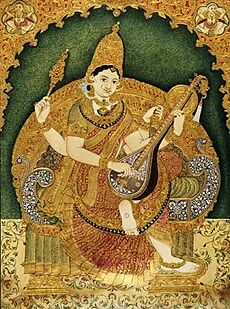
Mysore is called the cultural capital of Karnataka. It is famous for the Dasara festival, which is the state festival of Karnataka. King Raja Wodeyar I first started the Dasara celebrations in 1610. These festivities last for ten days. On the ninth day, called Mahanavami, the royal sword is worshipped. It is then carried in a parade with decorated elephants, camels, and horses.
On the tenth day, called Vijayadashami, the traditional Dasara procession takes place. This parade is known as Jumboo Savari. It usually happens in September or October. An idol of the goddess Chamundeshwari is placed on a golden platform. This platform is on the back of a decorated elephant. The procession includes music, dance groups, and other animals. It starts from the Mysore Palace and ends at Bannimantapa. There, a special tree called banni is worshipped. The Dasara celebrations end on the night of Vijayadashami with a torchlight parade.
Mysore is known as the City of Palaces because of its many beautiful palaces. The most famous is Amba Vilas, or Mysore Palace. Other notable palaces include Jaganmohana Palace, which is now an art gallery. Rajendra Vilas is also known as the summer palace. Lalitha Mahal has been turned into a hotel. The Jayalakshmi Vilas is another grand palace. The original Mysore Palace burned down in 1897. The current building was built in its place. The Amba Vilas palace looks Indo-Saracenic from the outside. But its inside shows a distinct Hoysala style. The Government of Karnataka maintains the Mysore palace. A small part is still used by the former royal family. The Jayalakshmi Vilas Mansion was built for Princess Jayalakshammanni. It is now a museum about folk culture and royal items.
The Mysore painting style came from the Vijayanagara Empire's painting school. King Raja Wodeyar (1578–1617 CE) supported this art. These paintings are special because they use gesso work with gold foil. Mysore is also known for its rosewood inlay work. In 2002, about 4,000 craftspeople worked on this art. The city gives its name to the Mysore silk sari. This is a women's garment made with pure silk and gold zari (thread). The Mysore Peta is a traditional turban worn by Mysore's former rulers. Men still wear it for some ceremonies. A famous local dessert from the Mysore palace kitchen is Mysore pak.
Mysore is home to the International Ganjifa Research Centre. This center studies the old card game Ganjifa and its art. The Chamarajendra Academy of Visual Arts (CAVA) teaches visual arts. These include painting, sculpture, and photography. The Rangayana theater company performs plays and offers theater courses. Famous Kannada writers like Kuvempu and U. R. Ananthamurthy studied and taught at Mysore University. R. K. Narayan, a famous English novelist, and his brother R. K. Laxman, a cartoonist, lived much of their lives in Mysore.
Fun Places to Visit
Mysore is a big tourist spot. It is also a good starting point to visit other attractions nearby. Many tourists come during the ten-day Dasara festival. The Amba Vilas Palace, or Mysore Palace, is one of India's most visited monuments. It is the main place for Dasara celebrations. The Jaganmohana Palace, the Sand Sculpture Museum, the Jayalakshmi Vilas, and the Lalitha Mahal are other palaces in the city. The Chamundeshwari Temple on Chamundi Hills and St. Philomena's Church are important religious sites.
The Mysore Zoo, started in 1892, is a popular place to visit. So are the Karanji, Kukkarahalli, and Blue Lagoon lakes. Blue Lagoon is a lake with a small island behind the KRS water dam. It's a great spot to watch the sunset and sunrise. Mysore also has several museums. These include the Regional Museum of Natural History and the Railway Museum. The city is also a center for yoga health tourism. Many visitors come to study yoga here.
Close to Mysore city is the Krishnarajasagar Dam and the Brindavan Gardens. Here, you can enjoy a musical fountain show every evening. Other historical places near Mysore are Ranganathaswamy Temple, Srirangapatna, Somanathapura, and Talakad. Hill stations like Ooty and Madikeri are also nearby.
For wildlife lovers, there are places like Nagarahole National Park. There are also bird sanctuaries at Ranganathittu and Kokrebellur. Bandipur National Park and Mudumalai National Park are also close by. These parks are home to animals like gaur, chital, elephants, tigers, and leopards. Other tourist spots near Mysore include the religious sites of Nanjanagud and Bylakuppe. You can also visit the waterfalls at Shivanasamudra.
Getting Around Mysore
Roads and Highways
Mysore is connected by National Highway 212 (India) to Gundlupet. From there, the road goes to the states of Kerala and Tamil Nadu. State Highway 17 connects Mysore to Bangalore. This road was improved in 2006, making travel faster. A new expressway between Bangalore and Mysore was planned in 1994. It is still not finished. State Highway 33 and National Highway 275 connect Mysore to H D Kote and Mangalore.
The Karnataka State Road Transport Corporation (KSRTC) runs buses within the city and between cities. A new division called Mysore City Transport Corporation (MCTC) has been suggested. Inside the city, buses are a cheap and popular way to travel. Auto-rickshaws are also available. Tongas (horse-drawn carriages) are popular with tourists.
Mysore also has a 42.5 km (26.4 mi) long Mysore Ring Road. The MUDA is upgrading it to six lanes. Mysore uses an Intelligent Transport System (ITS) to manage its city buses.
Trin Trin Bicycle Sharing
Trin Trin is a public bicycle-sharing system in Mysore. It is partly funded by the United Nations. This is the first public bike-sharing system in India. Its goal is to encourage people to use bicycles instead of cars. This helps reduce pollution and traffic. It also makes daily travel cheaper for citizens.
Train Travel
Mysore railway station has three train lines. They connect to Bangalore, Mangalore, and Chamarajanagar. The first railway line in the city was the Bangalore–Mysore Junction line, built in 1882. The lines to Chamarajanagara and Mangalore are single tracks and not electrified. The track to Bengaluru is an electrified double track. Mysore Railway Junction is part of the South Western Railway Zone.
Within Mysore city, there are two smaller stations: Ashokpuram and Chamarajapuram. The fastest train serving the city is the Shatabdi Express. It goes to Chennai through Bangalore. A new terminal is planned at Naganahalli to reduce crowding at the main station. In 2022, Prime Minister Narendra Modi started a project to upgrade the city railway junction. This project will add more platforms and lines. The Naganahalli station will also be expanded.
Air Travel
Mysore Airport is a domestic airport. It is near Mandakalli village, 10 kilometers south of the city center. The kings of Mysore built it in the early 1940s. Mysore Airport connects to cities like Chennai and Hyderabad. The current runway is not long enough for big planes. So, it will be expanded from 1.7 km to 2.8 km. After this, it will be upgraded to an international airport. The closest international airport is Bangalore Airport.
Education in Mysore
Before European education came to Mysore, Agraharas (Brahmin areas) taught Vedas to Hindus. Madrassas provided schooling for Muslims. Modern education started in Mysore in 1833 with a free English school. Maharaja's College was founded in 1864. A high school just for girls opened in 1881. It was later named Maharani's Women's College. The Industrial School, the first technical school, opened in 1892. This was followed by the Chamarajendra Technical Institute in 1913. Even with modern schools, places like the Mysore Sanskrit Pāthaśhāla (established in 1876) still teach Vedic studies.
The University of Mysore was founded in 1916. It was the sixth university in India and the first in Karnataka. Poet Kuvempu named it Manasagangotri ("fountainhead of the Ganges of the mind"). This university serves the districts of Mysore, Mandya, Hassan, and Chamarajanagar. About 127 colleges are connected to the university, with 53,000 students. Famous alumni include Kuvempu and N.R. Narayana Murthy.
Engineering education began in Mysore in 1946 with the National Institute of Engineering. This is the second oldest engineering college in the state. The Mysore Medical College, founded in 1924, was the first medical college in Karnataka. National institutes in the city include the Central Food Technological Research Institute and the All India Institute of Speech and Hearing. The city also has a private university called Amrita Vishwa Vidyapeetham.
Universities in Mysore
| Established | University | Type | Level | Specialisation |
|---|---|---|---|---|
| 1916 | University of Mysore | Public | Undergraduate, Post-Graduate, and Doctoral Research | Multi-disciplinary |
| 1948 | National Institute of Engineering | Private | ||
| 1996 | Karnataka State Open University | Public | ||
| 2008 | Karnataka State Music University | Public | Undergraduate and Post-Graduate | Music |
Important Institutes
| Established | Institute | Type | Affiliation | Level | Specialisation |
|---|---|---|---|---|---|
| 1992 | Mahajana Law College | Private | Affiliated to Mysore University | Undergraduate, LLB | Law |
| 1924 | Mysore Medical College & Research Institute | Public | Affiliated to Rajiv Gandhi University of Health Sciences | Undergraduate, graduate, post-graduate, and doctoral research | Medicine |
| 1928 | Yuvaraja's College, Mysore | Public | University of Mysore | Basic Science | |
| 1946 | National Institute of Engineering | Government-aided private | Affiliated to Visvesvaraya Technological University | Undergraduate, post-graduate | Engineering |
| 1950 | Central Food Technological Research Institute | Public | Set up by the Council of Scientific and Industrial Research | Research and development | Food technology |
| 1961 | Defence Food Research Laboratory | Set up by the Defence Research and Development Organisation | Defence and contingency food technology | ||
| 1963 | Regional Institute of Education, Mysore (NCERT) | Government | Affiliated to University of Mysore | Undergraduate, Post-graduate and Research in the field of Teacher Education | Educational Training and Research |
| 1966 | All India Institute of Speech and Hearing | Public | Commissioned by the Central Ministry of Health and Family Welfare | Undergraduate, graduate, post-graduate, and doctoral research | Audiology, speech, and hearing |
| 1945 | Sarada Vilas College | Private | Affiliated to Mysore University | Undergraduate, Graduate, LLB, Pharmacy | Educational |
| 1997 | Vidya Vardhaka College of Engineering | Private | Affiliated to Visvesvaraya Technological University | Undergraduate, Post Graduate, Research and Development | Engineering |
Media and Communication
Newspapers started in Mysore in 1859. Bhashyam Bhashyacharya published a weekly Kannada newspaper called Mysooru Vrittanta Bodhini. This was the first of many weekly newspapers. M. Venkatakrishnaiah, known as the father of Kannada journalism, was a famous publisher. He started several news magazines. Many local newspapers are published in Mysore. They cover news about the city and its surroundings. National and regional newspapers in English and Kannada are also available. Sudharma, the only Indian daily newspaper in Sanskrit, is published in Mysore.
Mysore had India's first private radio station. Akashavani (voice from the sky) started on September 10, 1935. M.V. Gopalaswamy, a psychology professor, set it up at his house. The Mysore state government took over the station in 1941. In 1957, Akashvani became the official name of All India Radio (AIR). The AIR station in Mysore broadcasts on 100.6 MHz. Gyan Vani broadcasts on 105.6. BIG FM, Radio Mirchi, and Red FM are three private FM channels in the city.
Mysore started getting television broadcasts in the early 1980s. Doordarshan (India's public broadcaster) began showing its national channel. This was the only channel until Star TV started satellite channels in 1991. Now, many direct-to-home channels are available in Mysore.
Sports and Recreation
The Wodeyar kings of Mysore loved games and sports. King Krishnaraja Wodeyar III enjoyed indoor games. He created new board games and made the ganjifa card game popular. Malla-yuddha (traditional wrestling) has been a part of Mysore's history since the 16th century. A wrestling competition is held during the Dasara celebrations. Wrestlers from all over India come to compete. An annual sports meeting is also held during Dasara.
In 1997, Mysore and Bangalore co-hosted the National Games of India. Mysore was the location for six sports: archery, gymnastics, equestrianism, handball, table tennis, and wrestling. Cricket is the most popular sport in Mysore. The city has five cricket grounds. Javagal Srinath, a famous Indian fast bowler, is from Mysore. Other well-known athletes from the city include Prahlad Srinath (tennis) and Reeth Abraham (heptathlon). The Mysore race course hosts horse races every year. India's first youth hostel opened in Mysore in 1949.
Famous People from Mysore
- Srimushnam Srinivasa Murthy (1923–2009), a freedom fighter and Kannada writer.
Sister Cities
- Cincinnati, Ohio, United States (2012)
- Nashua, New Hampshire, United States (2016)
See also
 In Spanish: Mysore para niños
In Spanish: Mysore para niños


